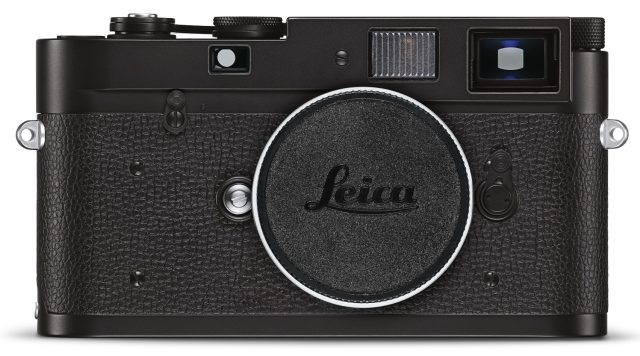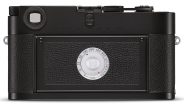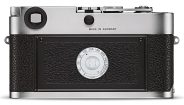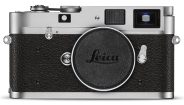Announced
Production status
System
Leica M system cameras
- Leica M (Typ 240)
- Leica M (Typ 262)
- Leica M Monochrom
- Leica M Monochrom (Typ 246)
- Leica M-A (Typ 127)
- Leica M-D (Typ 262)
- Leica M-E (Typ 220)
- Leica M-E (Typ 240)
- Leica M-P (Typ 240)
- Leica M1
- Leica M10
- Leica M10 Monochrom
- Leica M10-D
- Leica M10-P
- Leica M10-R
- Leica M11
- Leica M11 Monochrom
- Leica M11-P
- Leica M2
- Leica M3
- Leica M4
- Leica M4-2
- Leica M4-P
- Leica M5
- Leica M6
- Leica M6 (Typ 2248)
- Leica M6 Panda
- Leica M6 Titanium
- Leica M6 TTL
- Leica M6J
- Leica M7
- Leica M8
- Leica M8.2
- Leica M9
- Leica M9-P
- Leica MD
- Leica MD-2
- Leica MDa
- Leica MP
- Leica MP Original
Leica M-A (Typ 127)
35mm MF film rangefinder camera
Specification
| Format: | |
| 35mm full frame | |
Film type: | 135 cartridge-loaded film |
| Leica M [27.8mm] | |
| Shutter: | |
Type: | Focal-plane |
Model: | Mechanical |
Speeds: | 1 - 1/1000 + B |
| Exposure: | |
Exposure metering: | None |
Exposure modes: | Manual |
| Rangefinder and Viewfinder: | |
Rangefinder: | Built-in, combined with viewfinder |
Viewfinder: | Built-in, combined with rangefinder |
Finder magnification: | 0.72x |
Actual rangefinder base: | 69.25mm |
Effective rangefinder base: | 49.86mm |
Bright-line frames: | 35mm & 135mm, 28mm & 90mm, 50mm & 75mm |
Parallax compensation: | Yes |
| Physical characteristics: | |
Weight: | 578g |
Dimensions: | 138x77x38mm |
| Accessories: | |
Body cap: | 14195 |
| 14397 |
Manufacturer description #1
The pinnacle of mechanical technology: LEICA M-A. The precision tool for lovers of decelerated photograph
With the Leica M-System, Leica Camera AG, Wetzlar, is one of the few manufacturers still producing both analogue and digital cameras. In this, the company can draw from decades of experience in the construction of the finest precision-engineered cameras. Now – 60 years after the first Leica M rangefinder camera, the M3, left the factory to significantly change the world of photography – we have chosen the occasion of this anniversary to present a new analogue model: the Leica M-A.
As a purely mechanical rangefinder camera, the Leica M-A stands for a return to photography in its most original form. Without reliance on a monitor, exposure metering or batteries, photographers can explore entirely new creative horizons. Because, with a camera reduced to only essential camera functions, users of the M-A can now concentrate entirely on the essential parameters of subject composition – namely focal length, aperture and shutter speed – and on capturing the decisive moment.
From its shutter-speed dial and the aperture ring on the lens to the characteristic rangefinder focusing principle – the technical specifications of the Leica M-A are essentially based on the currently available analogue Leica MP. All of its precision-engineered components and functions are designed and constructed for absolute robustness and a long working life, and are housed in a painstakingly hand-built metal body. This ensures that the Leica M-A, as a product with particularly enduring value, brushes aside every challenge with absolute dependability.
The visible elements of the Leica M-A are as timeless as the precision-engineered principles employed inside it. For example, the Leica red dot was omitted to emphasise the classical simplicity of its design. Seen from the side, the Leica M-A is significantly slimmer than its digital counterparts.
The camera can be supplied in a choice of two different finishes: the classic appearance of the silver chrome version carries forward the traditions of 60 years of Leica M design. In the black chrome alternative, the M-A is reminiscent of the style of the M Monochrom and sets new standards in unobtrusiveness and discretion. While the silver chrome version of the M-A displays its origins in the engraving on its top plate, only much closer scrutiny of its completely matt black counterpart reveals the discreetly engraved Leica script on its accessory shoe.
Each Leica M-A is supplied complete with Kodak Tri-X 400 black-and-white film, which is also celebrating its 60th anniversary this year. Since its appearance on the market in 1954, its unmistakeable look, exceptional sharpness and tonal gradation, extremely broad exposure latitude and very good shadow detail made this black-and-white film a firm favourite and the classic medium for art and reportage photography.
The Leica M-A will be available from authorised Leica dealers starting October 2014.
Manufacturer description #2
As a purely mechanical camera, the Leica M-A is a precision instrument that has been so dramatically reduced to the essentials that it opens up entirely new creative horizons for photographers. It may have no monitor, no exposure meter, and no battery, but what it does have is a mechanical quality that makes Leica’s 100 years of experience instantly tangible. Photographers can read the shutter speed and aperture directly from the camera and lens and so concentrate fully on their subject. The acoustic signature of the shutter release of a Leica M-A is a delight that immediately reveals the precision-engineered excellence of its origin.
The exterior of the Leica M-A is as timeless as the precision engineering hidden inside. For instance, the Leica red dot has been deliberately omitted to emphasise the classic restraint of its design as an ultimate expression of understatement. Viewed from the side, the M-A is also noticeably slimmer than its digital counterparts.
The camera is available in two different finishes: the classic look of the silver chrome version continues the design tradition derived from 60 years of Leica M-Cameras. In the black chrome option, the M-A is reminiscent of the style of the M Monochrom and raises the bar in terms of unobtrusiveness and discretion. While an engraving on the top plate of the silver chrome M-A indicates its origins, only a closer look at its black-coloured counterpart reveals the Leica logo on its accessory shoe.
The M-System is not the only photographic legend celebrating its 60th birthday in 2014. Kodak Tri-X 400 film was also brought to life in 1954. With its exceptional sharpness, fine grain, and distinctive tonal gradation, extremely broad exposure latitude, and very good shadow detail, this black and white film soon became a firm favorite and a classic for art and reportage photography. And it’s also the perfect partner for the Leica M-A – which explains why Kodak Tri-X 400 film is included in the Leica M-A package.
Manufacturer description #3
The traditional, artisanal character of film photography reflects the zeitgeist of our age. The established domain of film aficionados has now begun to find increasing popularity among photographers of a generation that grew up with digital technology. The particular fascination of this traditional analog form of photography can be understood in the context of deceleration. Since a 35 mm film cartridge is generally limited to either 24 or 36 exposures every photo must therefore be thought through carefully before exposure. The omission of automatic functions allows photographers to concentrate completely on their subjects and the traditional principles of composition – focal length, aperture, and shutter speed. The decisive moment comes only when all settings are just right – the shutter button is then pressed and the light reflected from the subject is captured for eternity on the emulsion of the film inside the camera. In principle it’s a perfectly simple chemical and physical process, yet one that today continues to fascinate and amaze in the almost magical processes of developing and printing in the darkroom. The anticipation of holding a freshly developed photo in your hands is part of the unique joy of shooting with film. In the case of a photo on film, the result is always an original. Unique and exclusive, with an aura that none can resist and that cannot be precisely reproduced digitally.
Another key aspect of the emerging trend to analog is that it gets back to the roots of photography. Leica is one of very few manufacturers today to still produce cameras for both digital and film photography. And Leica can draw from a century of experience. A vast store of experience that is today reflected in the precision-engineered perfection of the classic film Leicas: the M-A, the M7, and the MP.
The shutter-speed dial, the aperture ring on the lens and the characteristic rangefinder for focusing: the new Leica M-A has everything a camera needs. 60 years after the first Leica M left the factory to conquer the world and change the face of photography, the Leica M-A now symbolizes a precision-engineered return to the essence of the art of photography.
The acoustic signature of the shutter release of a Leica M-A is a delight that immediately reveals the precision-engineered excellence of its origin. As a purely mechanical camera, the Leica M-A is a precision instrument that has been so dramatically reduced to the essentials that it opens up entirely new creative horizons for photographers. It may have no monitor, no exposure meter, and no battery, but what it does have is a mechanical quality that makes Leica’s 100 years of experience instantly tangible. Photographers can read the shutter speed and aperture directly from the camera and lens, concentrate fully on the subject, devote their attention to composition, and thus capture their personal view of the world for eternity. The shutter-speed dial, the aperture ring on the lens and the characteristic rangefinder for focusing: the new Leica M-A has everything a camera needs. 60 years after the first Leica M left the factory to conquer the world and change the face of photography, the Leica M-A now symbolizes a precision-engineered return to the essence of the art of photography.
The exterior of the Leica M-A is as timeless as the precision-engineered functional principles hidden inside. For instance, the Leica red dot has been omitted to emphasize the classical restraint of its design as an ultimate expression of understatement. Viewed from the side, the M-A is noticeably slimmer than its digital counterparts. The camera is available in two different finishes: the classic look of the silver chrome version continues the design tradition derived from 60 years of Leica M- Cameras. In the black chrome option, the M-A is reminiscent of the style of the M Monochrom and raises the bar in terms of unobtrusiveness and discretion. While an engraving on the top deck of the silver chrome M-A indicates its origins, only a closer look at its black-colored counterpart reveals the Leica logo on its accessory shoe.
The M-System is not the only photographic legend celebrating its 60th birthday in 2014. Kodak Tri-X 400 film was also brought to life in 1954. With its exceptional sharpness, fine grain, and distinctive tonal gradation, extremely broad exposure latitude, and very good shadow detail, this black-and-white film soon became a firm favorite and a classic for art and reportage photography. And it’s also the perfect partner for the Leica M – which explains why Kodak Tri-X 400 film is included in the Leica M-A package.
Special editions (4)
- Leica M-A (Typ 127) Titanium (250 units) - June 2022
- Leica M-A (Typ 127) "Edition 100" (101 units) - May 2014
- Leica M-A (Typ 127) "Leica Shop Vienna" (25 units) - November 2016
- Leica M3D Edition "David Douglas Duncan" (16 units) - November 2014
Similar cameras (13)
35mm full frame • Manual focus • Film • Rangefinder • Leica M mount
| Model | Shutter | Metering | Modes | Year |
|---|---|---|---|---|
| Cosina Voigtlander BESSA-R2 | M, 1/2000 | TTL • WA | M | 2002 ● |
| Cosina Voigtlander BESSA-R2A | E, 1/2000 | TTL • WA | AM | 2004 ● |
| Cosina Voigtlander BESSA-R2M | M, 1/2000 | TTL • WA | M | 2006 ● |
| Cosina Voigtlander BESSA-R3A | E, 1/2000 | TTL • WA | AM | 2004 ● |
| Cosina Voigtlander BESSA-R3M | M, 1/2000 | TTL • WA | M | 2006 ● |
| Cosina Voigtlander BESSA-R4A | E, 1/2000 | TTL • WA | AM | 2006 ● |
| Cosina Voigtlander BESSA-R4M | M, 1/2000 | TTL • WA | M | 2006 ● |
| Cosina Voigtlander BESSA-T | M, 1/2000 | TTL • WA | M | 2001 ● |
| Konica HEXAR RF | E, 1/4000 | TTL • WA | AM | 1999 ● |
| Leica CL aka LEITZ minolta CL |
M, 1/1000 | TTL • WA | M | 1973 ● |
| Minolta CLE | E, 1/1000 | TTL • WA | AM | 1980 ● |
| Rollei 35 RF | M, 1/2000 | TTL • WA | M | 2002 ● |
| Zeiss Ikon | E, 1/2000 | TTL • WA | AM | 2004 ● |





